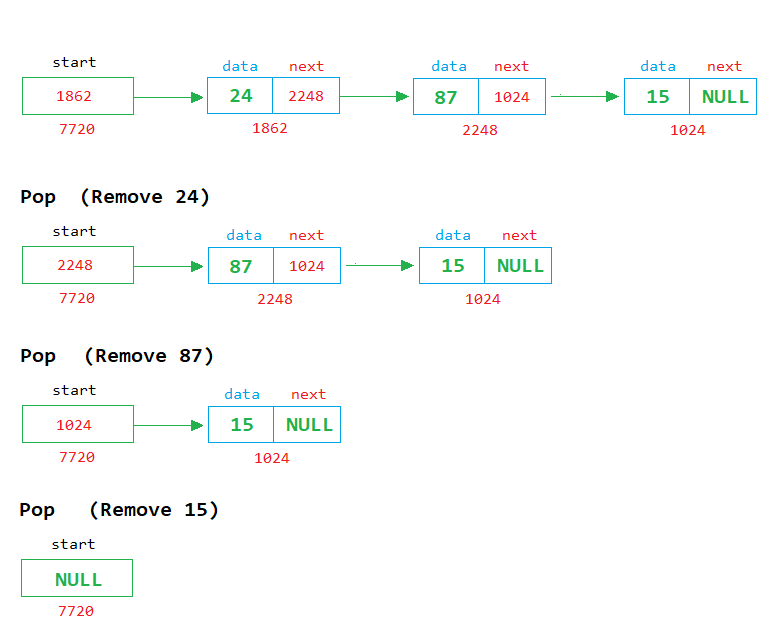

Stack supports operations such as push, pop, size, peek, and is Empty. It can be implemented either by using arrays or linked lists. Stack can be represented using nodes of a linked list. Computer Science Stack Java Data structure LIFO, stack, purple, blue png 1280x920px. Sorry for the poor image quality - I just drew it in paint. Stack Stack is a linear data structure which follows LIFO (Last In First Out) or FILO (First In Last Out) order to perform its functions. Brand Technology, Linked List, text, microsoft Azure png thumbnail. I would again emphasize that stacks/queues can be implemented by enforcing restrictions on linked lists. Each SLL is made up of two parts: a head and a tail. It has the following operations : push: push an element into the stack pop: remove the last element added top: returns the element at top of stack Implementation of Stack using Linked List Stacks can be easily implemented using a linked list. It is used to store data in a way that allows for fast insertion and deletion of elements. Stack using Linked List Stack as we know is a Last In First Out (LIFO) data structure. No, that would result in an undesirable behaviour. A doubly linked list of singly linked lists is a data structure that consists of a set of singly linked lists (SLLs), each of which is doubly linked. Each node consists of two fields, the information stored in a linked list and a pointer that stores the address of its next node. Nodes represent those data elements, and links or pointers connect each node.

In both the cases, you wouldn't want an arbitrary removal or insertion of elements at any index. A linked list is a linear data structure that stores a collection of data elements dynamically. This makes queue an excellent data structure to process jobs on a first come first serve basis. When performing a job, you would (not considering any optimization algorithms) serve the one first to arrive. Similar could be said for queue which is FIFO (First In First Out).

Thus the concept of First In (which was Site A) and Last Out (the last one to go in was Site D which in turn became the first one to go out) Then when the user hits back button, you pop the one at the top (removing from tail - the same end used for insertion) which gives the last visited site - C. Basic steps to implement a stack using a. Some are built into the Java language: int, double, String, Most are not: Complex, Picture, Stack, Queue, ST, Graph, Data structures: this lecture Represent data or relationships among data. A linked list is a collection of data items called nodes, where each node in the list holds a pointer to the next node. This ensures that the current site is always at the top of the stack. 4.3 Stacks, Queues, and Linked Lists Data Types and Data Structures Data types: Set of values and operations on those values. As a user moves ahead, you first push (insert at tail) the list of websites. You navigate to Site A -> then B -> then C -> D. Delete the temporary node using the ‘free’ function.Stacks and queues have their own reason of existence.Ī stack is a FILO (First In Last Out) or LIFO (either ways) data structure that could be implemented using arrays, linked lists or other forms.Point the ‘top’ pointer to the node next to the current top node.Store the value of ‘data’ of this temporary node in a variable.Point this temporary node to the top of the stack A Singly-linked list is a collection of nodes linked together in a sequential way where each node of the singly linked list contains a data field and an address field that contains the reference of the next node.So, we will first make a temporary pointer to the current top node and delete it using the ‘ free’ function later. A Singly-linked list is a collection of nodes linked together in a sequential way where each node of the singly linked list contains a data field and an address field that contains the reference of the next node. In order to do so, we need to make the ‘top’ pointer point to the node next to the topmost node but this will led the current topmost node inaccessible. In pop operation, we delete the topmost node and returns its value. To sum up our brief discussion, we have learnt that the Linked List is a simplest and dynamic data structure that can be used to implement others structures such as Queue and Stack. The linked list data structure is designed to be efficient for insertion or removal of elements from any position in the list. So, let’s deal with the pop operation now. You must have understood the push operation. The last step is to make the ‘top’ pointer point to this new node – top = tmp The third step is to point the ‘next’ of the new node to the top of the stack and this is done in the next line – tmp -> next = top. The second step is to give ‘data’ of this new node its value and this we are doing with tmp -> data = value. The first step is to make a new node and we are doing the same by node * tmp tmp = malloc(sizeof(node))
#LINKED LIST STACK PICTURE CODE#
Read the comments in the code for better understanding.


 0 kommentar(er)
0 kommentar(er)
